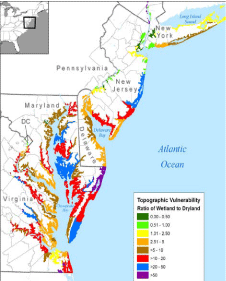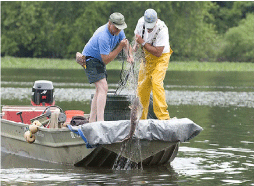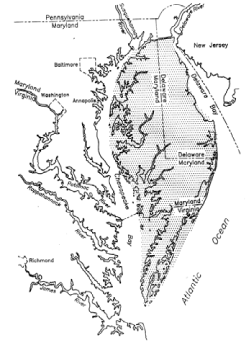Make the best use of Scientific Research and information from our 700+ peer reviewed, Open Access Journals that operates with the help of 50,000+ Editorial Board Members and esteemed reviewers and 1000+ Scientific associations in Medical, Clinical, Pharmaceutical, Engineering, Technology and Management Fields.
Meet Inspiring Speakers and Experts at our 3000+ Global Conferenceseries Events with over 600+ Conferences, 1200+ Symposiums and 1200+ Workshops on Medical, Pharma, Engineering, Science, Technology and Business
Editorial Open Access
The State of Delaware Facing Significant Impacts due to Wetland Loss Resulting from Sea Level Rise: A Microcosm of the Macrocosm
| Gulnihal Ozbay*1 and Amy Cannon2 | |
| 1,2Department of Agriculture and Natural Resources, Delaware State University, DE, USA | |
| Corresponding Author : | Gulnihal Ozbay Department of Agriculture and Natural Resources Delaware State University, 1200 North DuPont Highway Dover, DE 19901, USA E-mail: gozbay@desu.edu |
| Received May 15, 2012; Accepted May 18, 2012; Published May 21, 2012 | |
| Citation: Ozbay G, Cannon A (2012) The State of Delaware Facing Significant Impacts due to Wetland Loss Resulting from Sea Level Rise: A Microcosm of the Macrocosm. J Earth Sci Climate Change 3:e105. doi:10.4172/2157-7617.1000e105 | |
| Copyright: © 2012 Ozbay G. This is an open-access article distributed under the terms of the Creative Commons Attribution License, which permits unrestricted use, distribution, and reproduction in any medium, provided the original author and source are credited. | |
Visit for more related articles at Journal of Earth Science & Climatic Change
| Every wetland habitat along the entire continental shelf and beyond into tidal creeks and canals, acts as a natural filter for terrestrial pollutants and sediments (Figure 1). Whether one thinks that these ecosystems form in relationship to their biota or in relationship to their environment in autogenic or allogenic succession processes [1], all schools of thought tend to agree on the relevance of these ecosystems. By offering their filtration they offer a worldwide system of healthy kidneys for the body of the Earth. The water pulses into and out of these habitats as blood through veins, bringing in nutrients and removing potentially harmful elements. Delaware is facing the question of how to address concerns over sea levels rising and deciding what actions are necessary to prevent further degradation of the wetlands along its coasts. These examples serve to highlight a small portion of a much larger problem. |
| Does Delaware face significant impacts due to wetland loss resulting from sea-level rise? According to the United States Environmental Protection Agency (EPA), wetlands diminishing into open water may be of little concern when compared to a more urgent matter. Alterations of wetlands to dry land throughout the coastal areas of the United States are a much more pressing problem. This is because a large amount of land bordering the water could be vulnerable to rising sea level resulting from warming of the atmosphere [2]. Loss of coastal wetland (Figure 2) has been documented as a significant threat that will affect all coastal communities [3]. The Delaware Bay and Inland Bays are classified as one of the areas with greatest amounts of land at risk due to rising sea levels [4]. Because much of the elevation of Delaware’s coasts is 1.5 m above sea level, and sea-level rise is occurring in greater amounts than wetlands are able to accrete in nearby areas [4], Delaware does indeed face serious consequences of losing wetlands as a repercussion of rising sea levels. |
| A global gain in sea levels has been documented by many recent scientific studies [5-7]. Delaware Department of Natural Resource and Environmental Control (DNREC) states that one of the more telling occurrences of climate change is loss of wetlands due to rising sea levels [8]. Between 1984 an 1993, the area of degraded marshes in Delaware Bay increased from 25% to 54%, and by the end of this century, many of Delaware Bay’s coastal marshes could disappear [8]. |
| The other side of this issue lies in political differences of opinion. Real estate values play a part in decisions made by policymakers in their resolutions reached regarding protections of wetlands. Although metropolitan and industrialized areas of the coasts in high-level income economies are somewhat safeguarded, financial asset injuries in these areas are not likely to be serious unless climate-induced dangers end up being quite forbidding or conservation costs become unreasonably priced [9]. In some locations, environmental regulations have prevented people from building directly on wetlands, yet they have not prevented people from building just inland of the marsh [10]. As sea level rises, development of coastal lands, as well as construction of bulkheads to protect economic development may prevent wetlands from forming upland of where they existed previously [10]. |
| Wetlands are the most productive ecosystems found on the planet [11] that can provide vital spawning and migration habitats for many fish and shorebirds [12]. In the fishing industry, it is important to note that wetlands are an important breeding ground for coastal fish species [8]. One of the tourist attractions in Delaware is sport fishing (Figure 3) in the bays. Loss of wetlands from Delaware can be economically devastating when we consider that local sport fishing generates approximately $110 billion yearly in Delaware Inland Bays alone [11]. Equivalently, in Delaware’s Inland Bays, in 1992, domestic travelers spent $813.3 million and international visitors spent an additional $62 million in the State [11]. Economic losses will occur if sport fishing becomes unavailable in these areas due to wetland and habitat loss for fisheries. |
| The most intelligent course of action suggests the need to protect property rights with a balanced respect for the shoreline. To that end, some states have “rolling easements,” where people are allowed to build along the coast, but only on the condition that they will remove the structure if and when it is threatened by advancing shoreline [10]. In these rolling easements, it is explicitly noted that property owners are not allowed to build structures to hold back the sea. Delaware has been very forward-thinking in this way, since it is unlawful to construct a bulkhead on properties along Delaware coast [7]. The option of preventing development which will decrease property owner’s motivation to hold back the sea [10] is highly recommended for action in addition to rolling easements. This, in addition to Delaware Wetlands Act §6602, will protect Delaware’s coast for present and future generations’ health, enjoyment and economic prosperity. |
| Although the Delmarva Peninsula (Figure 4) is being affected by sea-level rise, there is a connection between problems faced in Delaware, the rest of the nation and all global wetlands. Steps are being taken, as in PL-566 adopted by the Department of the Interior that allows technical and financial assistance to local watershed management groups for small watersheds [13]. Delaware has begun implementing changes in various wetland structures to help revitalize natural habitats from drainage ditches and damaged shorelines to help the hydrology of the region to become more stable and productive [14]. The Ramsar Convention is an intergovernmental treaty that administers a structure for national courses of action and international coalition for the conservation and wise use of wetlands across all global communities [1]. This treaty originated in 1971 and remains active with 160 countries that are actively participating in this collaborative effort [15]. Future generations will be better served as actions are taken by as many groups as possible to protect wetlands from the threats of climate change and sea-level rise. Delaware is a miniature example of the larger global concerns that apply to all wetland ecosystems. |
References
|
Figures at a glance
 |
 |
 |
 |
| Figure 1 | Figure 2 | Figure 3 | Figure 4 |
Post your comment
Relevant Topics
- Atmosphere
- Atmospheric Chemistry
- Atmospheric inversions
- Biosphere
- Chemical Oceanography
- Climate Modeling
- Crystallography
- Disaster Science
- Earth Science
- Ecology
- Environmental Degradation
- Gemology
- Geochemistry
- Geochronology
- Geomicrobiology
- Geomorphology
- Geosciences
- Geostatistics
- Glaciology
- Microplastic Pollution
- Mineralogy
- Soil Erosion and Land Degradation
Recommended Journals
Article Tools
Article Usage
- Total views: 13743
- [From(publication date):
June-2012 - Apr 03, 2025] - Breakdown by view type
- HTML page views : 9196
- PDF downloads : 4547
